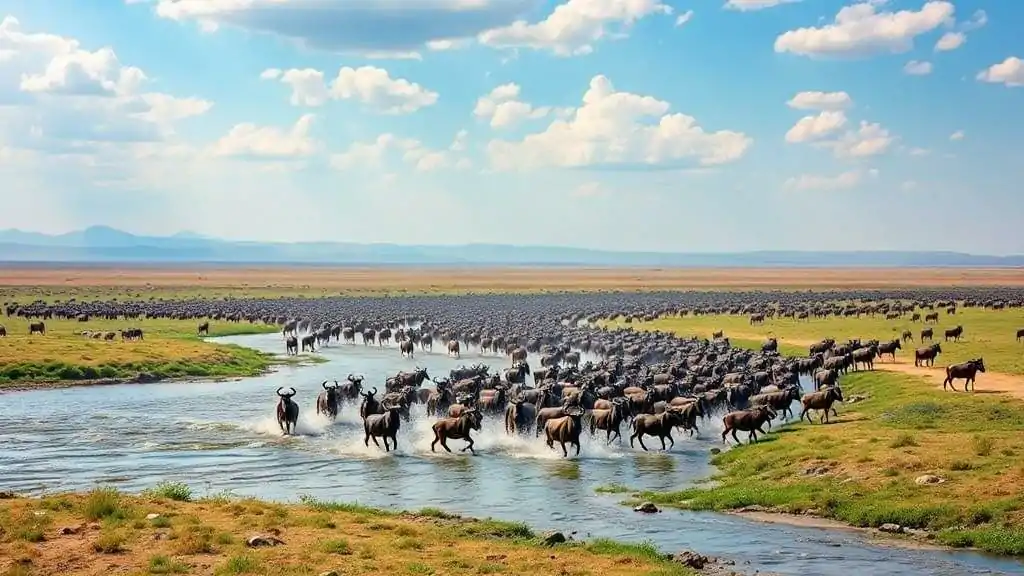The Great Wildebeest Migration is one of planet Earth’s most awe-inspiring natural events – a relentless cycle of movement as over 1.5 million wildebeest, accompanied by hundreds of thousands of zebras and gazelles, sweep across the plains of Tanzania's Serengeti and Kenya's Maasai Mara in search of fresh grazing. For wildlife enthusiasts, witnessing this spectacle is the ultimate safari dream.
But timing and location are everything. Upana Safaris is here to guide you on when and where to position yourself for the best views of this incredible phenomenon.
Understanding the Migration Cycle (A Year-Round Journey):
It’s important to remember the migration is a continuous, circular movement, largely dictated by rainfall patterns. Here’s a general monthly guide:
- December - March (Southern Serengeti & Ndutu, Tanzania): Calving Season
- The herds congregate on the short grass plains of the Southern Serengeti and the Ngorongoro Conservation Area (specifically the Ndutu region). This is calving season, with hundreds of thousands of wildebeest born within a few short weeks (typically February). This abundance of vulnerable young attracts predators, making for dramatic action.
- Upana Safaris Tip: Excellent for seeing newborn calves and predator interactions.
- April - May (Serengeti, Tanzania): The Long Rains & Dispersal
- The herds begin to move north and west from the southern plains as the long rains arrive. They often split, with some heading towards the Serengeti’s Western Corridor and others further north. This period can be wet, and some camps may close, but it’s a lush, green time with fewer crowds.
- Upana Safaris Tip: A quieter time, beautiful green landscapes, but rain can impact game drives.
- June - July (Western Serengeti & Grumeti River, Tanzania / Approaching Maasai Mara, Kenya): River Crossings Begin
- The herds consolidate in the Serengeti’s Western Corridor and reach the Grumeti River. This is where the first dramatic river crossings often occur, as wildebeest brave crocodile-infested waters. As July progresses, the herds push further north towards the Maasai Mara.
- Upana Safaris Tip: First chances for thrilling Grumeti River crossings.
- August - October (Northern Serengeti, Tanzania & Maasai Mara, Kenya): The Mara River Crossings – Peak Drama!
- This is arguably the most famous period. The herds arrive in the Northern Serengeti and Kenya’s Maasai Mara, facing the perilous crossings of the Mara River. These crossings are incredibly dramatic, with massive herds plunging into the water, battling currents and waiting crocodiles.
- Upana Safaris Tip: Prime time for the iconic Mara River crossings. Book accommodation and permits very far in advance. This is peak season.
- November - December (Serengeti, Tanzania): The Return South
- With the arrival of the short rains in Tanzania, the herds begin their journey south again from the Maasai Mara, through the Lobo area and central Serengeti, back towards the fertile southern plains for the next calving season.
- Upana Safaris Tip: Good for seeing large herds on the move, fewer crowds than August-October.
Kenya (Maasai Mara) vs. Tanzania (Serengeti): Where to Go?
- Maasai Mara National Reserve, Kenya:
- Best from late July/August to October when the herds are concentrated here for the Mara River crossings.
- The Mara is smaller than the Serengeti, which can mean higher vehicle density during peak season but also easier access to crossing points.
- Offers options for hot air balloon safaris and Maasai cultural visits.
- Serengeti National Park, Tanzania:
- Offers a year-round migration experience as the herds move through different parts of this vast ecosystem.
- The Southern Serengeti (Ndutu) is ideal for calving season (Dec-Mar).
- The Western Corridor (Grumeti River) is key in June/July.
- The Northern Serengeti (near the Mara River) is prime from July to October.
- The sheer size of the Serengeti can mean a more exclusive feel even during peak times in certain areas. Mobile camps that move with the migration are a fantastic option here.
Planning Your Migration Safari with Upana Safaris:
- Book Early: This is crucial, especially if traveling during peak river crossing seasons (July-October). Accommodation and flights fill up months, even a year or more, in advance.
- Consider a Mobile Camp: In Tanzania, mobile camps move with the herds, offering an immersive experience.
- Be Patient: River crossings are wild and unpredictable. You might wait hours, or even days, for a crossing to happen. Enjoy all the other incredible wildlife the Serengeti and Mara offer in the meantime!
- Combine with Other Experiences: Enhance your migration safari by adding on a visit to the Ngorongoro Crater in Tanzania, or primate trekking in Uganda/Rwanda for a diverse East African adventure.
Ready to witness the Greatest Show on Earth? Contact Upana Safaris today, and let our experts design your unforgettable Great Migration safari!

